Everybody knows that a crock pot is for slow cooking.
It’s all about infusing those herbs, mixing in meat juices, and generally pulling as much flavor as possible into your potential meal. So, with that in mind, is it safe to leave food all day in a crockpot or overnight?
It’s a little bit of ‘yes’ and a little bit of ‘no’, but don’t worry – it’s all about knowing how the crockpot works and what it does to the food inside. Stay with us and we’ll clear it right up so that you can cook with confidence!
Temperature and Time – What you need to know
While you are used to the straightforward ways that your stove and oven cook foods, your slow-cooking crockpot are a wee bit different. Imagine a closed environment, with heat and humidity isolated into the space of your pot to slowly cook your food.
The temperature ranges that are employed fall into 170 – 280 degrees Fahrenheit, which is 76.6 – 137.7 degrees Celsius. The direct and prolonged heat, along with the constantly recycled steam, act to destroy harmful bacteria while also taking all of the fine flavors from everything that you’ve added to infuse your meal with a medley of tastes.
With these temperatures you don’t have to run the risk of getting food poisoning. This has quite a few advantages over other cooking methods. For instance:
It’s low maintenance
Cooking food on a stovetop or with an oven means that a lot of overseeing is required.
With a stovetop, you’re flipping and checking foods to prevent burning, while an oven is much the same. With either, if you leave it alone for too long, your food becomes a crispy, inedible mess. You might even start a fire!
With a crockpot, you basically pile in your ingredients, mix them up well, and simply leave it alone to ‘do its thing’. When you come home in the evening or wake up in the morning after a long, successful cook, it’s just a matter of tasting your food and switching the crock pot to ‘warm’ if it’s ready or adding more ingredients to taste.
If you work long hours or need to feed a family with the least amount of fuss, a crock pot is pretty much a godsend – it’s about as low maintenance as it gets.
Flavors meld slowly and neatly
Slow cooking ensures that flavors are not wasted. Meats get cooked in their own juices, with delicious fats that you’ve left in melting and mixing with the herbs that you’ve added to infuse the meat with their flavors.
Vegetable flavors, whether they are subtle such as with a rich tomato paste, or sharp like white onions or garlic, are made to ‘play together’ – the onion and garlic are not as sharp, but definitely present, and yet they won’t overpower the tomato flavor.
When you use an oven or a stovetop, flavor literally drifts away in the air or gets ‘burnt out’ by the intense heating, with a crockpot it’s all in a tiny, enclosed space, circulating through steam so that you are wasting as little flavor as possible. That’s the beauty and allure of it.
Tough meats and veggies become softer
An enormous advantage final advantage to list is the fact that cheaper or frozen meats and tough vegetables are no match for the crock pot’s slow, concerted cooking effort. The heating element below, along with the circulated flavor in the very air slowly hydrate and soften the toughest meats and vegetables – all while making them more delicious.
Let’s face it – you can’t have high-grade steak every day and some vegetables simply aren’t worth the trouble without employing the low-maintenance approach of the crock pot.
Adding a crock pot to your healthy eating regime might save you time on meal prep!
Warming temperatures
Once your meal is cooked, it’s important to know what the ‘warm’ function is going to do to them in order to properly assess if you can use it, or if you need to stow away your food for reheating later. Well, the warming temperature of your crockpot is typically 145 -165 degrees Fahrenheit, which is roughly 63 – 74 degrees Celsius. The range we’ve listed is a rough estimate, as it will vary from model to model, with 145 being the normal minimum temperature across the board.
This is important to know because bacteria is always a problem, but the good news per Kansas University is that slow cooker food safety experts advise that at 125 degrees your crockpot starts killing bacteria. Some will still survive, up until you reach 140. At 140 degrees Fahrenheit/60 degrees Celsius, the temperature is hot enough that the remaining bacteria start to die.
Once this temperature has been maintained for a period of 1 hour, all of the bacteria should be destroyed. This means that the average warming temperature for a crock pot after you’ve cooked the meal should keep your food safe from harmful bacteria.
Old slow cookers
We should note, if you have an older cooker that doesn’t have as much temperature control, then you might want to consider an upgrade. While a good crockpot can last for many years, components such as the heating element do need to be replaced from time to time.
As crock pots are relatively inexpensive, the most cost-effective way to do this is to simply upgrade. You can always test it (and we’ll go into this later in the article) but this is an important factor so you should keep it in the back of your mind.
The liquid factor
We mentioned that steaming is an important part of the process, so in order to help ensure that your crockpot doesn’t end up lowering the food quality, you need to make sure that you have enough liquid for your recipe.
It’s vital, as you are cooking in two ways – the heating element below and the heated, moist air inside — so always make sure that you are following your recipes to a ‘T’.
Without enough water, you can dehydrate meats and veggies to some extent, especially with a long cooking time. We’ll talk more about certain foods later to help paint a better picture of these scenarios so that you can avoid them, but for now, we’ll cover more cooking factors before we go there.
How long can I leave my slow cooker on, anyways?
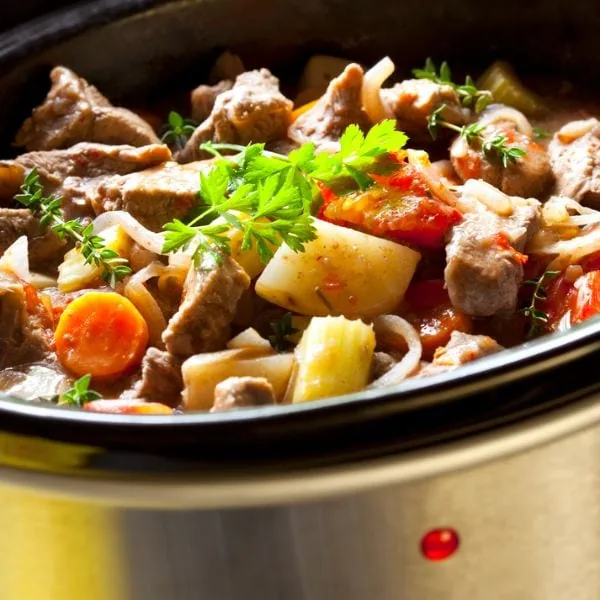
While your ‘warm’ function will help to keep bacteria at bay, it is not intended for reheating your food, it’s just there to keep it warm and yummy until you’re ready to eat. The ideal recommended time for using this is 2 to 4 hours.
Furthermore, unless you have a crock pot that lets you set the warm time to automatically shut off, then usually they can run for up to 20 hours before they will automatically turn off from a cook or a warm. While this should keep the bacteria away, longer cooks than necessary are not really a good idea.
The best way to describe the effect is to think about High School lunches and detention. If you had detention, you weren’t allowed to associate with the other kids, so you would usually get to go a little later to get your food after it had been sitting under a heat lamp for a while.
Well, with your crockpot, heating beyond the necessary parameters is similar, except there is excessive moisture.
Food can get soggy at first, and then with prolonged periods, some liquid-turned-vapor can escape and then dry the food a little. It’ll be warm and safe to consume, but it could be soggy or dry and most certainly blander.
After all, when vapor escapes, so does some of that flavor you’ve been carefully cultivating in your slow cooker.
Can I turn it off and leave the food inside?
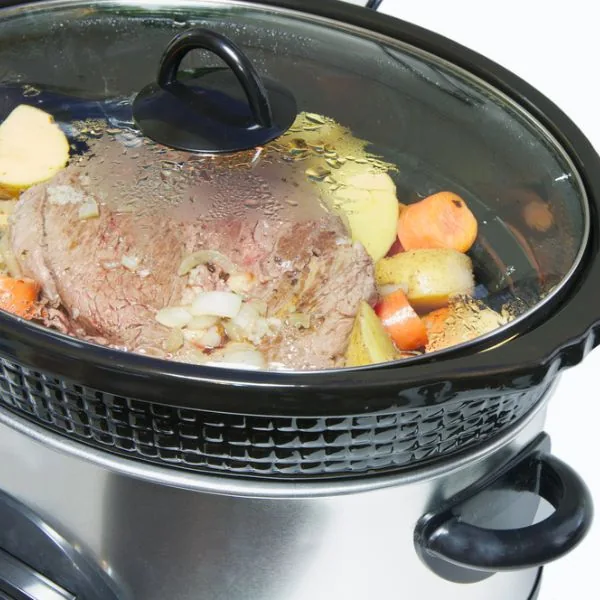
You could, but that’s not a very safe thing to do.
As the temperature lowers, you have a warm, dark place that is perfect for bacteria growth. Bacteria cultures can quickly multiply without sustained higher temperatures to keep them away.
As the bacteria enjoy the meal that was supposed to be for you, they are continuously producing acids to break it down and like any organism, after a good meal they will be an excreting waste. How long this takes can vary, but a warm, dark environment is just about as perfect as it gets for harmful bacteria.
So, while you COULD turn it off and leave the food inside, you definitely SHOULDN’T.
When in doubt, why not test it?
According to the U.S. Department of Agriculture, bacteria grow fastest when unheated foods are at a temperature range of 40 to 140 degrees Fahrenheit/4.5 to 60 degrees Celsius. While 140 maintained constantly can kill them in an hour, food that has been left alone without a heating factor becomes extremely vulnerable, with bacteria being able to double their numbers in as little as 20 minutes.
Yikes!
They recommend that you don’t leave food unattended for longer than 2 hours, but if you aren’t sure about the time that has passed, then you can always use a food thermometer to check the temperature of your meal inside the crockpot.
If it’s close to 140, then you haven’t left it unattended for very long, so if you don’t intend to eat right now then it’s a good idea to put the food away into a plastic container. Do NOT stick your crockpot in the refrigerator.
The warmer temperature of the pot will increase the overall temperature inside of the refrigerator and also, the cool temperature of the fridge can make your crock pot cool faster than it is designed for. That means putting the crock pot in your fridge is bad for both appliances.
After you’ve tested the food, the safest way to store it is in a plastic Tupperware or similar container and then to put it in your refrigerator or freeze it if the food may be safely frozen.
Things you CAN leave in your crockpot overnight
We’ve covered the function of your crockpot, so now to drive the lesson home we’re going to give you some practical examples of foods that are good for an all-day or slow cooker overnight, and then we’ll go into some that should definitely be avoided.
Let’s take a look!
1. Pot Roasts
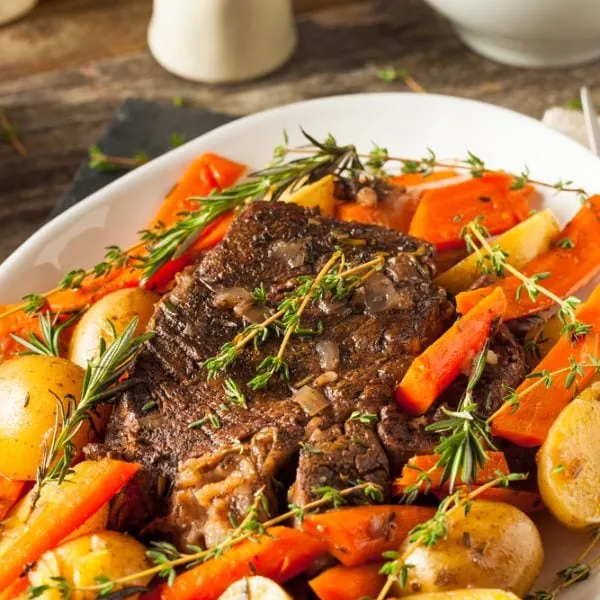
Pot roast typically has a good amount of delicious fat on it and while that’s frowned upon from a nutritional perspective, it sure is delicious!
It also just so happens to be an excellent slow-cooking option. The fat gets slowly rendered, as your roast soaks up the herbs you’ve chosen and the juices of flavorful vegetables so that your resulting roast is tender and delicious.
2. Whole chickens
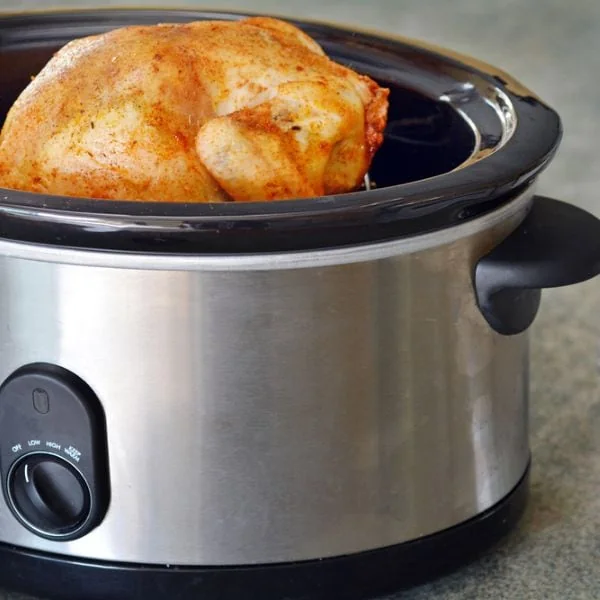
Whole chickens are much the same as roasts. Notice that we mentioned WHOLE chickens, however.
Chicken is a leaner meat but with a whole chicken, you’ve got some fats in there to help to keep your that fine fowl from drying out. A slow cook will thus infuse the meat with the yummy flavor factors you’ve introduced and you’ll have a delicious meal waiting once it’s done.
You can also use frozen chicken, saving you the time and energy that would be needed for an oven roast. The juices that marinate the chicken will enhance the flavors.
3. Ribs
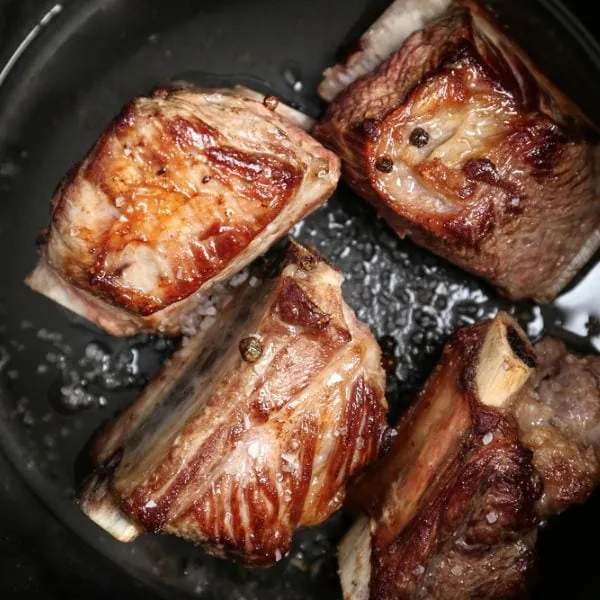
Ribs are an ideal option. They have a little fat but also, but the barbecue sauce can really soak in nicely with a large slow cooker.
Salt, pepper, and other spices also cease to be singular things but combine into the sauce and the meat for a truly memorable medley that will play well on your taste buds.
4. Chili
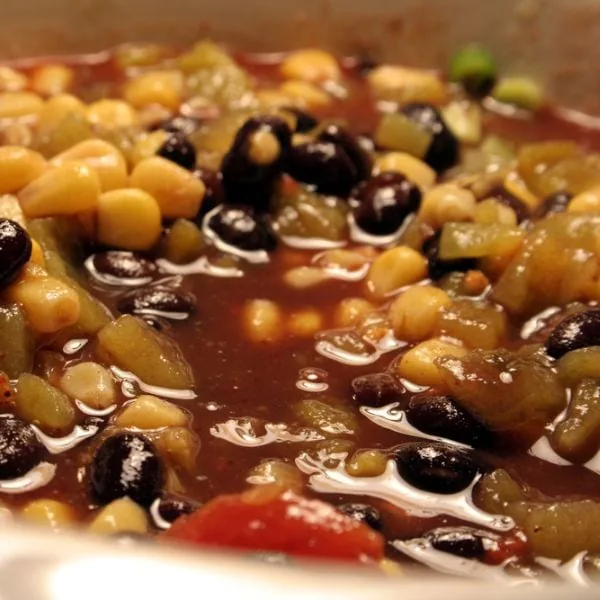
Chili is another good example of a certified-safe slow cook. It’s got a lot of liquid, but also veggies and usually meats that are present. With slow, controlled heating, it all starts to become perfect.
The peppers you’ve put in will suffuse heat into the mix, while the meat will stay juicy but also share its flavor with added beans (or no beans, we won’t start that old argument), and the end result is better than you’d get with a plain old boil.
5. Stew
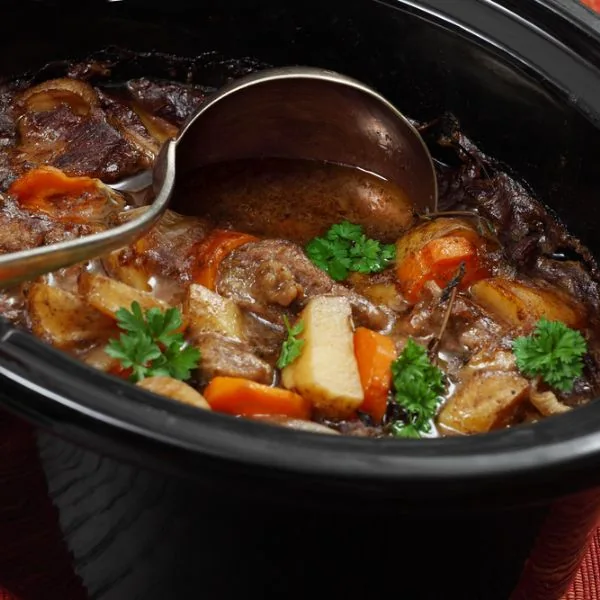
Making a stew of whatever is around the house or simply making use of leftovers is another fine slow-cooking function. The timed cook ensures that your stew will thicken nicely, without becoming gelatinous if you are careful with the starch content, and the end result will be spectacular.
6. Jambalaya
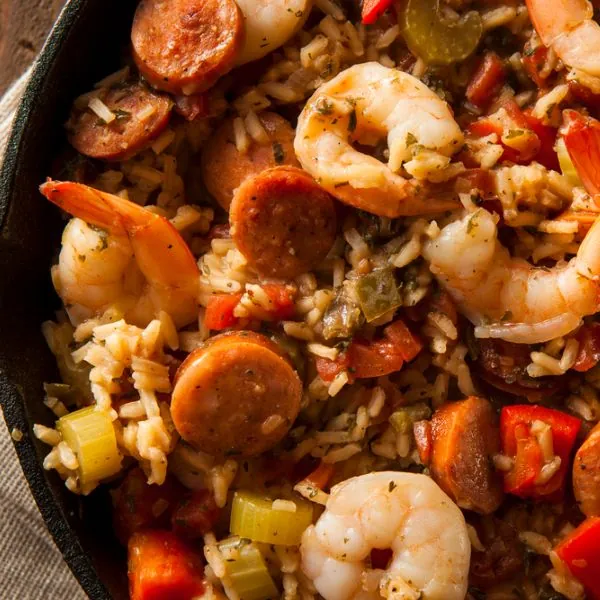
Cajun Jambalaya is definitely a crock pot favorite and approved. Cajun flavors are very carefully intermixed and while you can achieve it on a stovetop, it’s arguably easier and better in a slow, controlled cook.
7. Pork Tenderloins
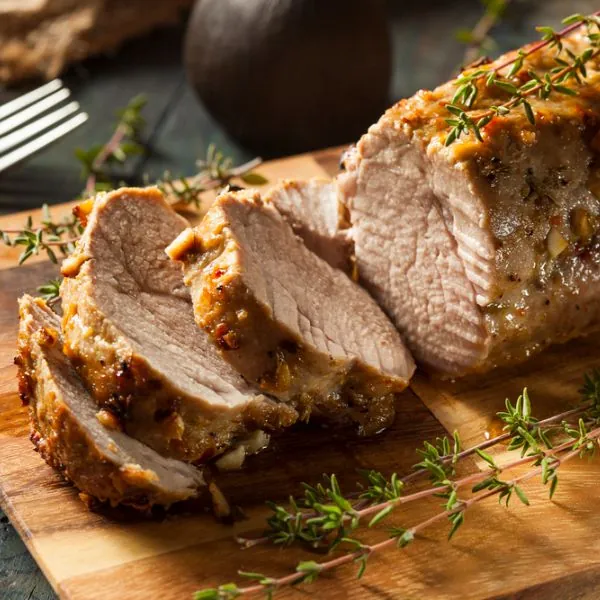
Tenderloins, especially with fun glazes such as a simple mix of cornstarch, soy sauce, sugar (or honey), and balsamic vinegar can make your pork POP. Consider it officially approved for a dedicated slow-cook to perfection.
8. Ropa Vieja
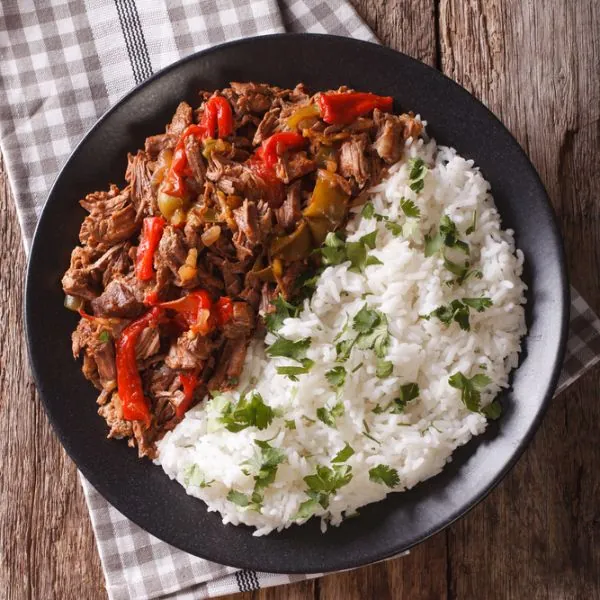
If you love a good Cuban Ropa Vieja, then try making it in your crockpot. A simple salt and pepper treatment of the meat is all you need for a spectacular, slow-cook blending with your tomato sauce for results that will keep you, your family, and a few lucky friends coming back for more.
9. Soups
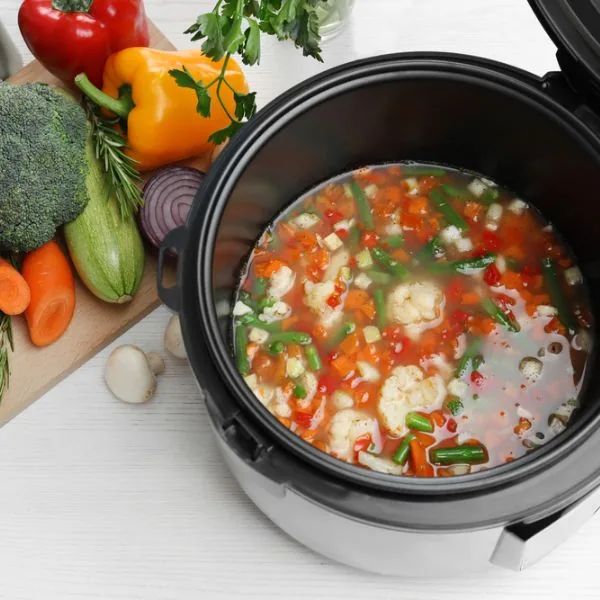
A proper soup is like kitchen alchemy and every good cook knows it. The crockpot gives you the opportunity to mix flavors both strong and subtle that you simply can’t cook properly any other way.
On a stovetop, much of it will evaporate, and even sealed up and oven-cooked the higher heat won’t always be optimal. A Crockpot does the work just right.
10. Cheaper cuts of meat
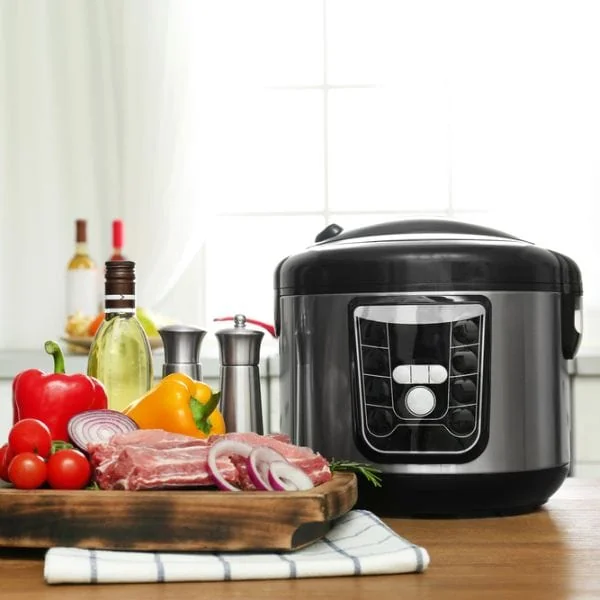
We touched on this in brief before, but to make things crystal clear, tough cuts of meat can come out brilliant with a slow cooker and so this is definitely an approved option. To be more specific, cuts such as rounds, shoulders, and chuck are ideal options for tenderizing with the power of slow heating and flavorful steams. They’ll come out tender and juicy and all you need to do is 5 – 10 minutes of prep and then simply wait for it!
Things not to leave in your crockpot overnight
While a lot of foods can be improved with a long cook, there are certainly exceptions and this will help to complete your mental picture of what to cook and what not to cook for a prolonged period. Let’s explore the ‘unrecommended’ foods and the reasons why this is the case.
1. Plain Rice
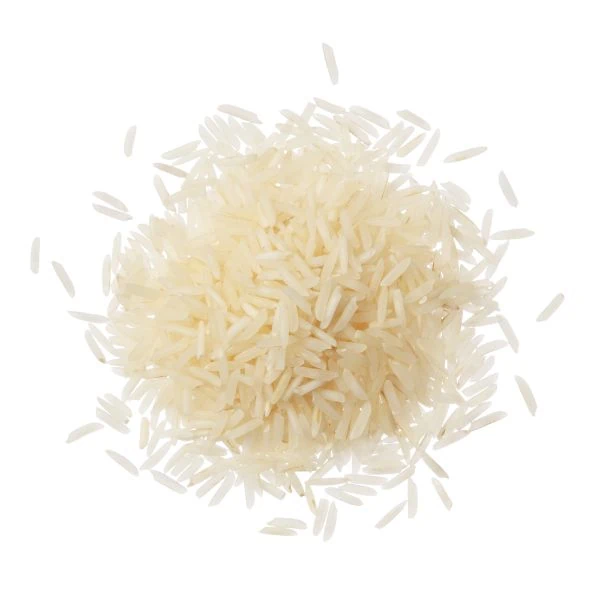
Rice is better cooked in a boiling pot or a rice cooker. The biggest reason for this is the starch content, especially with United States rice. Starch, when heated for long periods of time, gets sticky. This causes your rice to clump and change its flavor of it.
In the United States, as part of the refinement process nutrients and extra starch are added to rice granules. As such, while you can briefly add it for a cook, an extended one is NOT advised. It will gel up your meal and you will definitely notice that.
2. Lean Meats
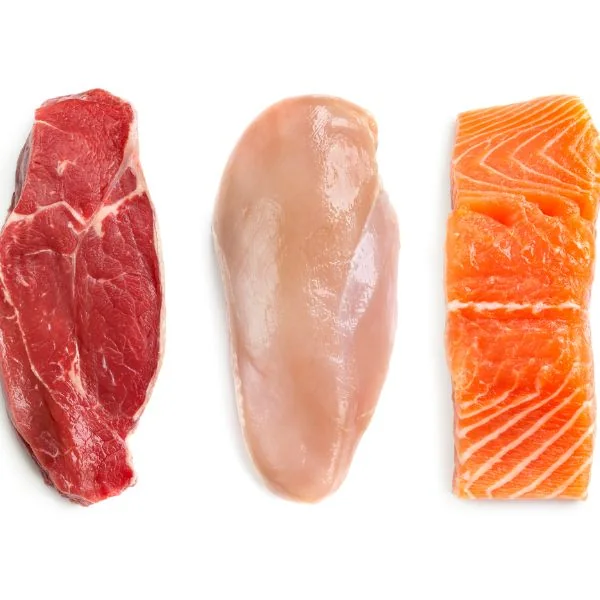
Lean meats, such as smaller pieces of chicken (on their own, rather than in a soup) and especially fish will not do well in extended cooks. Even if you are introducing strong flavors, such as curry, with your crock pot it’s going to be a case of ‘less is more’.
To be more specific, a slow cooker with lean meats is fine, but an extended one can dry them a little or simply make them too bland for you to be happy with.
3. Vegetables
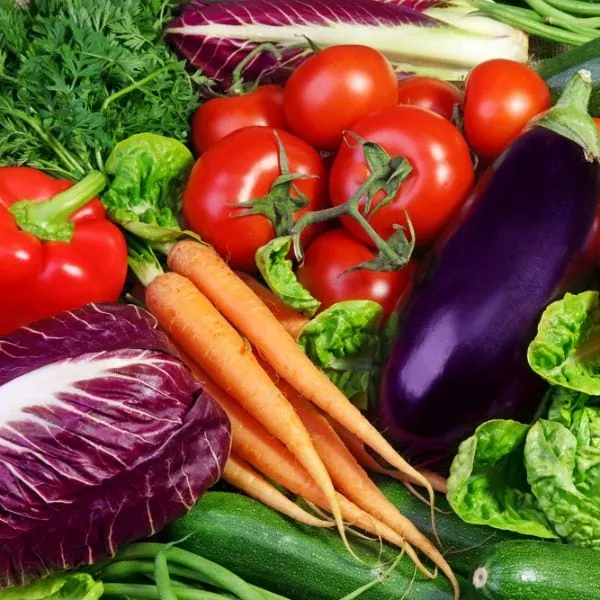
Vegetables can do some neat tricks in your crock pot, but cooking times should be short. This is because vegetables cook much faster than many other foods and so a long cook means that can easily overcook into blandness.
4. Pasta
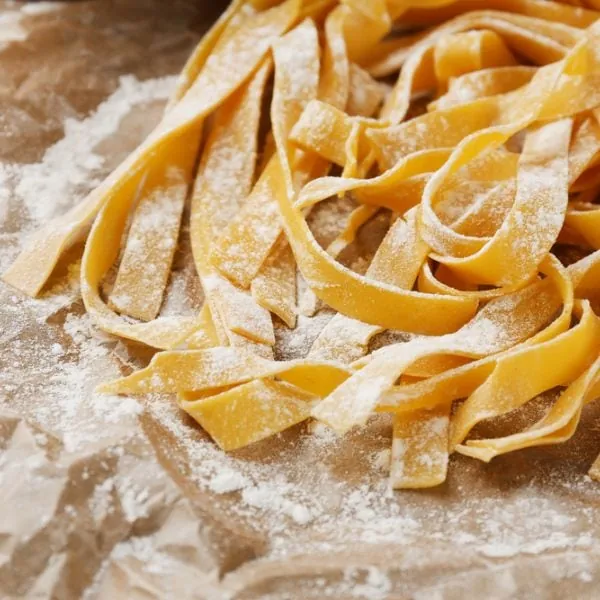
Pasta is a bit of ‘yes’ and ‘no’, but it’s not complicated/ If you are cooking pasta with soups or with meats, then a slow cooker should be okay, but if you are just cooking the noodles then that’s a definite ‘no’. They’ll end up too soggy and might even break apart a bit, so it’s not recommended.
5. Cous Cous
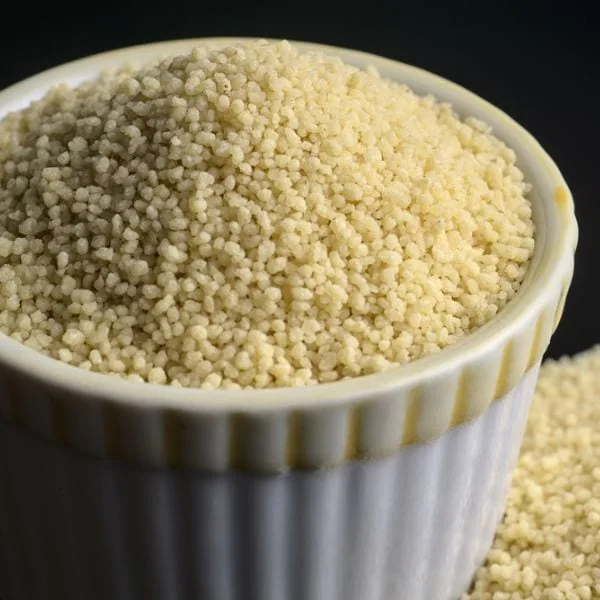
Cous Cous is not good for a long cook. Not only do you get the ‘gel factor’ from the high amounts of starch, but it will go from ‘fluffy to ‘mushy’ fairly quickly in your hot, steamy crock pot.
6. Creamy delights
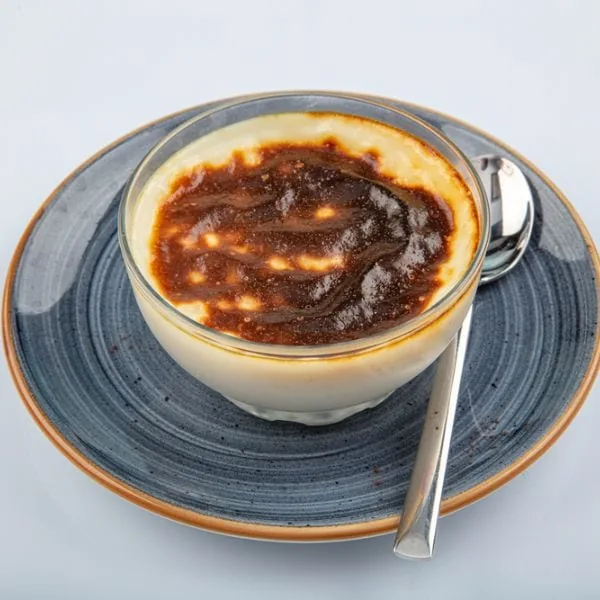
Speaking of creamy, while you can make amazing desserts in your crock pot, almost ALL of these recipes are quick cooks – typically a 2-hour run in the crock pot at most. Prolonged cooks will take away flavor and can curdle up or create other undesirable effects on the cream you’ve carefully cultivated, too.
Consider Creamy Delights a slow-cook ‘no’! Look for suitable slow cooker recipes that will satisfy your sweet tooth.
7. Appetizers
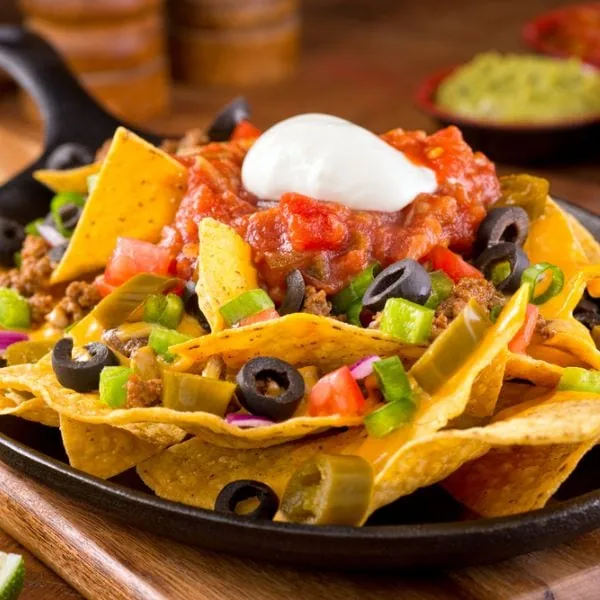
Appetizers are another item that generally won’t do well with a long cook.
They’re finger foods, after all, and with a smaller mass, they will be heavily affected by long cooking times. Examples include cocktail sausages, cheese dips, crock pot nachos… you get the idea!
These items can all be made in a crockpot, but it’s generally a 1 – 3 hour cook at best – anything longer will wilt the chips, dry the sausages, and wreak other types of unintended chaos that will cost you flavor.
Some closing words on leaving foods in your crockpot
Now that you know how your crockpot works you should have a better idea of what you can cook for long times and what is best avoided. Generally, small items are at risk for overcooking, as well as solo vegetables which generally will cook faster than meats and blended selections.
On the flip side, soups, stews, and less expensive cuts of meat will all do well with slow cooks, as they will become tender and flavorful over time with your care, controlled cook. Finally, don’t forget to limit the use of the ‘warm’ setting to 2 – 4 hours, and don’t leave food in your crock pot when it’s off.
The first scenario will make your food less flavorful, while the second could make you ill! Just stick to the rules that we’ve established today and tour crock pot fare will always be favorable and at its best!





David learned to cook at an early age after his mother told him that he couldn't live on pizza forever, Dave uses his modest kitchen skills to recreate sorely-missed recipes from home and to occasionally make new favorite ones from places he is visiting.